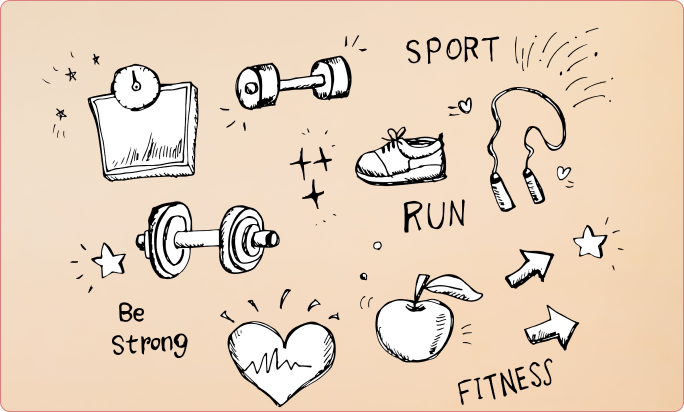It’s a common concept – people believe their weight gain is due to a slow metabolism which is dictated by your genetics and age. And while this is true, it’s not the whole picture: weight gain is often not as simple as a slow metabolism.
Metabolic reset is the idea that we can set our metabolism back to “normal” which implies that it can be in dysregulation or not working as well as it could be.
Our metabolism responds to changes regularly: muscle mass, weight, and stages of life can affect it.
We can positively impact our metabolic rate which is what many people are looking for when they are aiming for a “metabolic reset”.
Some quick definitions
The term metabolism is used to refer to the overall process of how our bodies burn energy on a day-to-day basis to maintain life. We can estimate the amount of energy we burn daily through total estimate energy requirement equations. You may have heard of RMR (resting metabolic rate) or BEE (basal energy expenditure).
The amount of energy we burn in a day is the sum of the total energy used to digest food, to maintain other basic functions of the body, to sustain non-exercise related activity, and do exercise related activity.
Calories in < Calories out
Energy input and output can be measured in calories. We can increase our total energy requirements to help create a calorie deficit. This can result in weight loss. To do this we can increase activity, eat more protein, and/or increase muscle mass. We can also limit calorie intake to achieve a calorie deficit.
The hunger is real though
However, hunger often plays a large role in how many calories consume. When we try to lose weight, our bodies’ response is to increase hunger hormones and decrease satiety (or feeling of fullness) hormones. Weight loss through exercise or nutrition alone can lead to this response. This response can lead to excessive hunger and decreased satiety. Experiencing excessive hunger may eventually lead to poor nutritional choices. It can also increase the calories that we consume. Similarly, cravings can also be a barrier to choosing healthy choices. Cravings may become overwhelming the longer that we ignore them.
Medications to the rescue
Medications such as Saxenda and Contrave can help reduce hunger and cravings.
Saxenda is an injectable medication and acts like a hormone that is already present in the body called Glucagon-Like-Peptide (GLP-1). This hormone is normally released when food enters the intestine. and plays a role in those feelings of being full. With decreased hunger, we can decrease our calorie intake, thus helping to lose weight.
Contrave is an oral medication. It helps to reduce cravings and hunger by focusing on chemicals in the brain. It targets the reward system area and the part that controls our urge to eat which typically results in less impulsive and less excessive eating.
Weight loss starts in the kitchen
But it’s important to choose healthy food options even while using medications.
When we decrease our food intake, we can increase the risk of deficiencies. It is smart to eat nutritionally dense foods to reduce the risk of this. Nutritionally dense foods include fruits, vegetables, wholegrains, and lean animal proteins, and non-processed plant-based proteins. Deficiencies can happen in all sorts of diet, but particularly for those that are vegan or vegetarian.
It is also beneficial to limit our consumption of energy dense foods that are also low in essential nutrients. These foods include those delicious deep-fried foods, white grain products, fatty cuts of meat, and processed plant-based proteins.
Protein to stay fuller, longer
Protein also has a higher thermic effect (uses more energy to digest than you get from the food itself) than carbohydrates and fats. This can positively impact our metabolic rate. Protein also helps reduce muscle loss. As we lose weight, we often lose both muscle and fat. While we are happy when we lose fat, losing muscle means we’re actually reducing the amount of energy we burn. This can lead to larger reductions in your metabolic rate if too much muscle is lost.
Exercise helps retain muscle and burns calories
It is also important to provide our muscles with enough stimulus.
Resistance-based exercise (also called strength or weight training) can help to retain muscle.
Start easy and slow when starting a resistance routine. Focus on learning basic movements first. When comfortable, move onto challenging your muscle until near fatigue. Resistance exercise also increases our energy output. You can use resistance-bands, weights, bodyweight, or exercise machines to do resistance exercise.
It is also important to consider cardio-based activity. Cardio can include activities like cycling, walking, and swimming. Cardio often burns more total calories during a single session than resistance. It can also improve your overall cardiovascular health.
Non-exercise related activity (cleaning, unloading groceries, chasing after kids) can also increase the total calories burned in a day. These activities add up, mainly because we don’t notice that we’re doing them and we do them all day!
To see how much these non-exercise activities can add to your health, measure them with smart watches or a pedometer.
There are many factors related to our calorie balance and thus our metabolic rate. Adding medications can help with hunger and cravings. However, it is important to consider lifestyle related factors. This helps improve health and weight management.
Metabolic resets are a good way to review your health, habits and take the opportunity to make changes to help with your weight loss goals. A combination of medication, active lifestyle and good food choices will help immensely.





